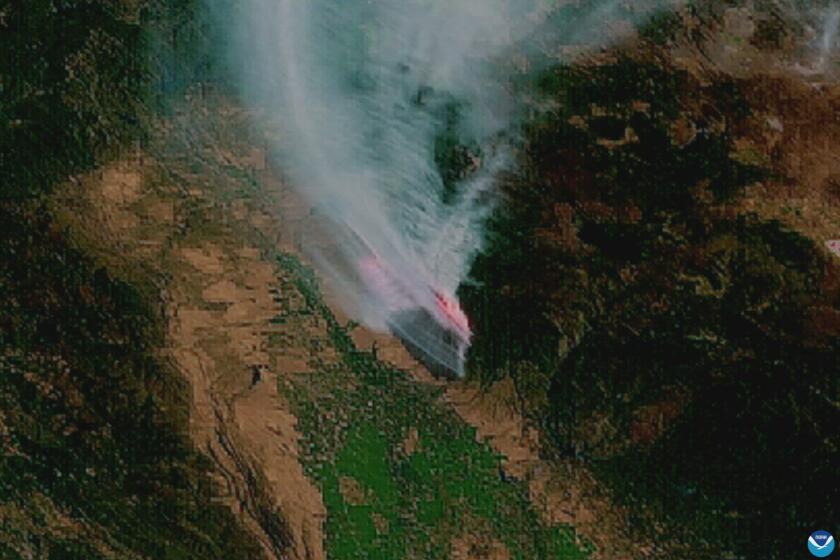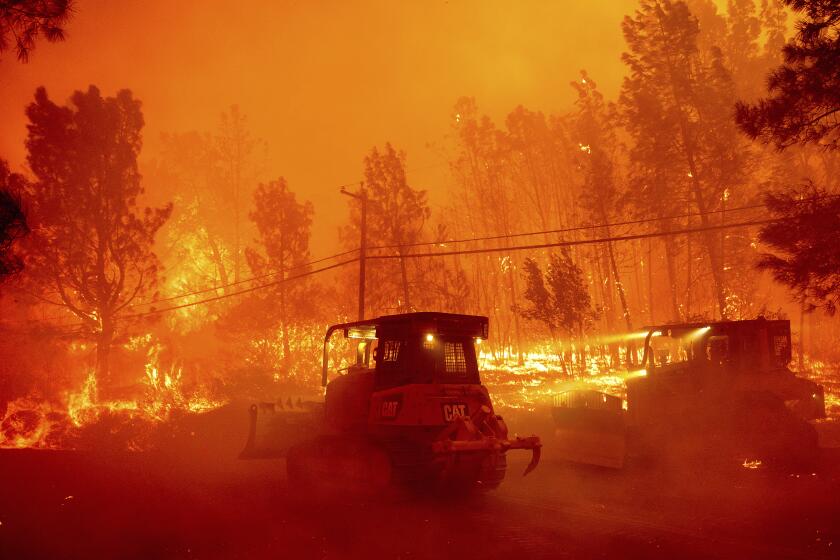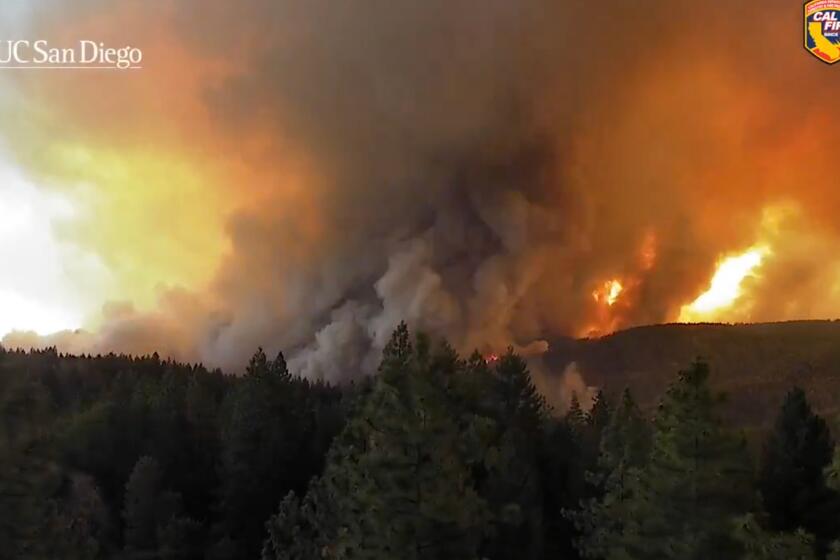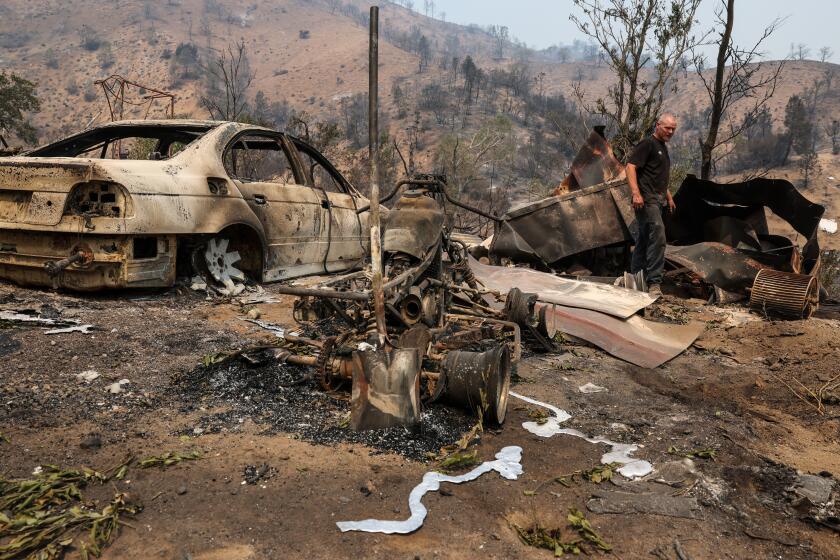Park fire flares up as crews scramble to contain 360,000-acre blaze
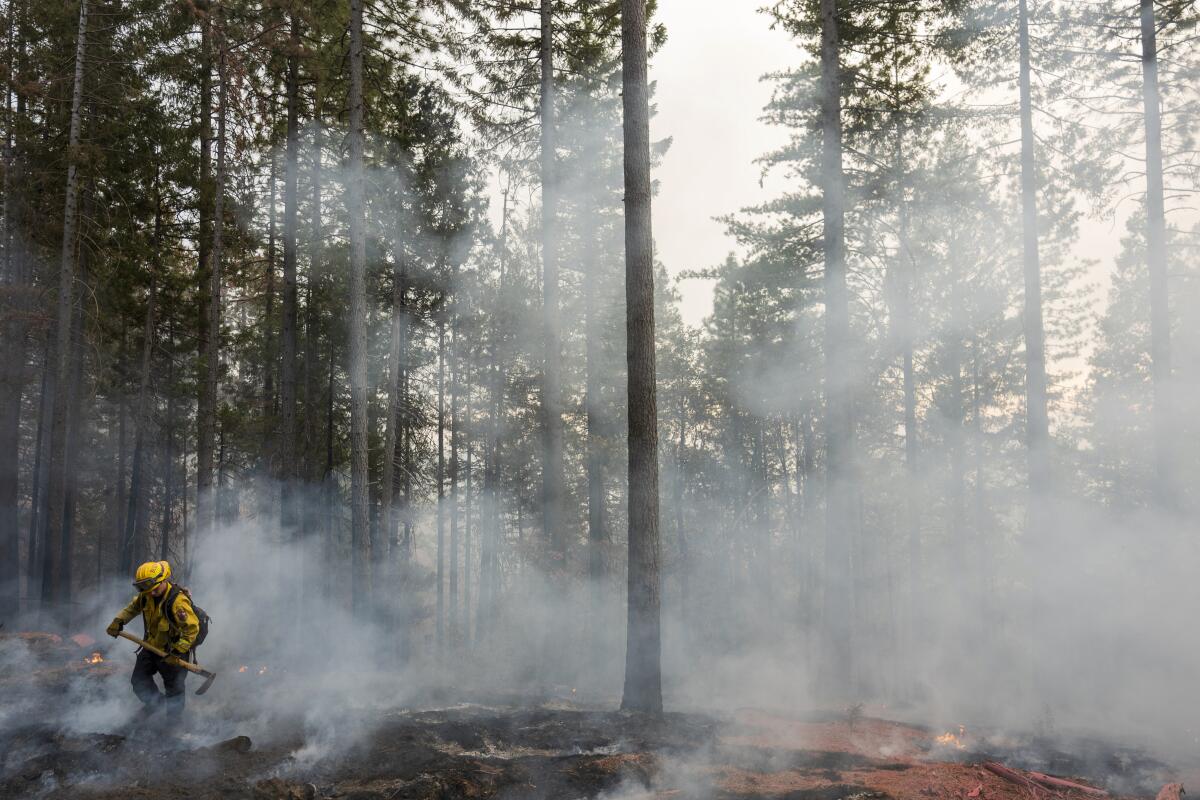
- Share via
Firefighters on Sunday were contending with rapidly changing conditions while battling the massive Park fire burning in Butte, Plumas, Shasta and Tehama counties — California’s largest wildfire of the year and the state’s seventh-largest fire on record.
The 360,141-acre blaze was 12% contained owing largely to a brief break in hot, dry weather conditions over the weekend, but the fire flared up again in several locations on Sunday and made some “pretty significant runs,” according to the California Department of Forestry and Fire Protection.
“We are seeing increased fire activity within the incident this afternoon,” operations section chief Mark Brunton said during an afternoon news conference.
The video, taken over several hours Friday into Saturday morning by a NOAA satellite, shows dramatic plumes of smoke from the Park fire.
Crews will continue to face an uphill battle this week with higher temperatures and lower humidity on the horizon as the fire continues to burn in heavy vegetation.
“We’re kind of at the mercy of the weather, the fuel and the topography — those are the three driving factors of any fire,” said Jay Tracy, a spokesperson for the incident.
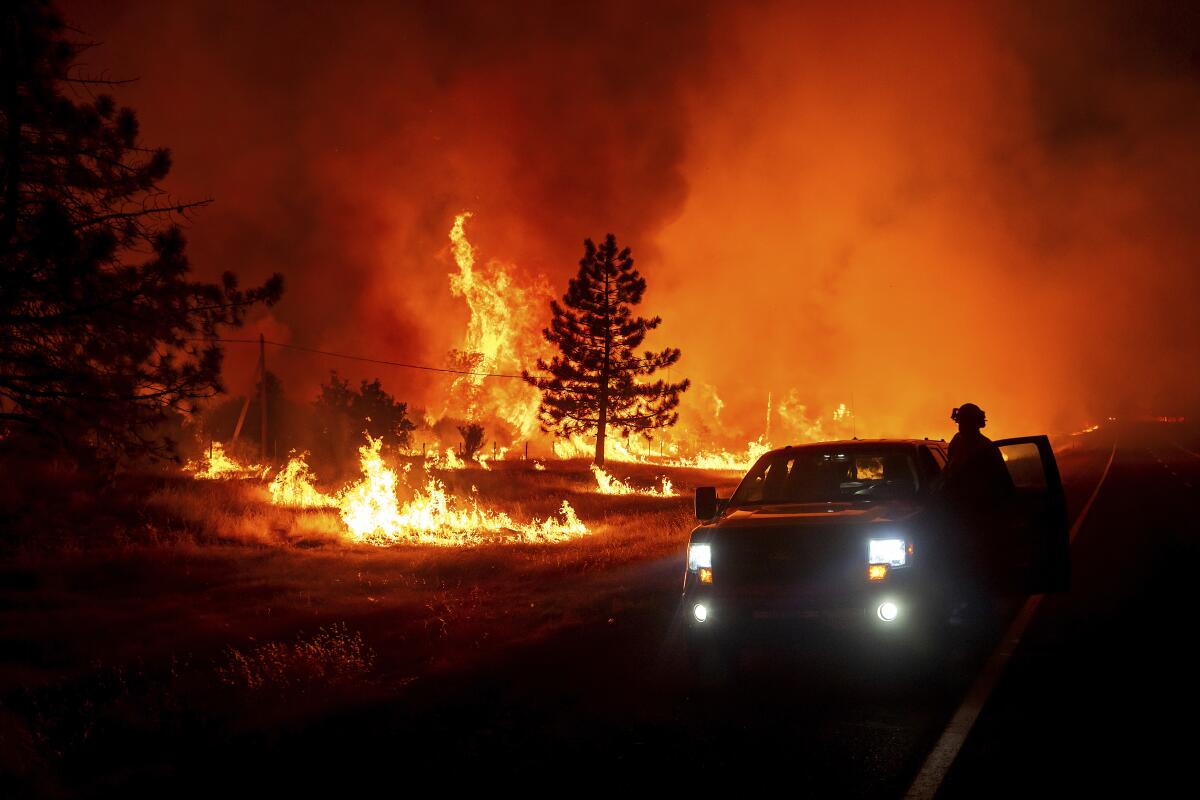
The explosive wildfire ignited Wednesday afternoon after a man pushed a burning car into a gully near Chico in what authorities say was an act of arson. About 4,200 people have been evacuated from their homes, and at least 67 structures have been destroyed and 4,200 remain threatened.
More than 4,000 firefighters are attacking the blaze from the air and ground. But the fire is burning in steep, jagged terrain that is proving difficult to access — including areas such as the Ishi Wilderness that haven’t burned in decades and so are overgrown and rife for fire, Tracy said.
A perfect storm of hot, dry winds, untouched brush and remote topography has fueled explosive growth of the Park fire north of Chico, now over 350,000 acres.
“There’s not any infrastructure in there that would have the roads and the access points that we need,” he added.
The fire is largely crawling in a northeasterly direction, where communities such as Paynes Creek remain a top concern. The fire has also made runs toward Deer Creek, Lomo and other areas along Highway 32 where it is moving into some heavier vegetation, officials said.
“We are experiencing some challenges along the 32 corridor,” Cal Fire incident commander Billy See said during the news conference.
Another community of concern — Cohasset on the fire’s southern perimeter — has so far been spared due to a combination of “luck and hard work,” according to Zeke Lunder, a Chico-based fire specialist and geographer.
Satellite imagery of the blaze captured by the European Space Agency show many active spots of heat and flames, but also some beneficial forest management and fuel reduction projects that have helped keep some areas protected, Lunder said in a briefing Saturday evening.
Most evacuation orders remain in effect, but some were downgraded to warnings on Sunday afternoon, including areas of Rock Creek and Richardson Springs.
The explosive Park fire north of Chico created massive smoke plumes that whirled up into the atmosphere, swirling in a tornado-like way, a phenomenon known as a “firenado.”
However, forecasters say luck could soon change. Although a low-pressure system delivered significantly cooler and moister conditions to the region over the weekend, the days ahead are likely to bring a gradual increase in temperatures and decrease in humidity, according to Sara Purdue, a meteorologist with the National Weather Service in Sacramento.
“We’re looking at potential for triple digits by next weekend,” Purdue said. “There is some uncertainty in the forecast still, but it’s going to be a slow transition back to those warmer-than-normal temperatures.”
The fire has prompted a state of emergency declaration from Gov. Gavin Newsom, who said Saturday that he had secured additional federal assistance to help battle the blaze.
“This is already one of the biggest fires in California history, and we’re continuing to see dangerous conditions — our firefighters and emergency responders are working day and night to protect our communities,” Newsom said in a statement. “Californians must heed warning from local authorities and take steps to stay safe.”
‘We lost everything — it’s all gone,’ a Havilah resident said as the Borel fire in Kern County devastated the mining town.
Indeed, the Park fire is far from the only blaze burning in California, where crews are contending with more than two dozen active wildfires.
In Kern County, the Borel fire has seared through more than 38,000 acres and was 0% contained on Sunday, according to Capt. Andrew Freeborn with the Kern County Fire Department.
The fire began Wednesday in the Kern River canyon and spread rapidly as it moved through the canyon and met with strong winds along the ridges, he said.
“We’ve been under red flag warning conditions, and the fire continues to burn in a very, very intense and erratic way,” Freeborn said. “The flames can be seen from miles away. If you’re looking for what extreme fire behavior would be defined as, we’re seeing it on this fire.”
Evacuation orders and warnings have been issued throughout the area. Freeborn said structure damage is still being assessed; however, there has been significant structure loss in the historic mining town of Havilah.
The Borel fire is being managed with two other fires in Kern and Tulare counties, collectively referred to as the SQF Lightning incident. The other fires are the Trout fire, which has burned 23,369 acres and is 25% contained, and the Long fire, which has burned 9,204 acres and is 35% contained.
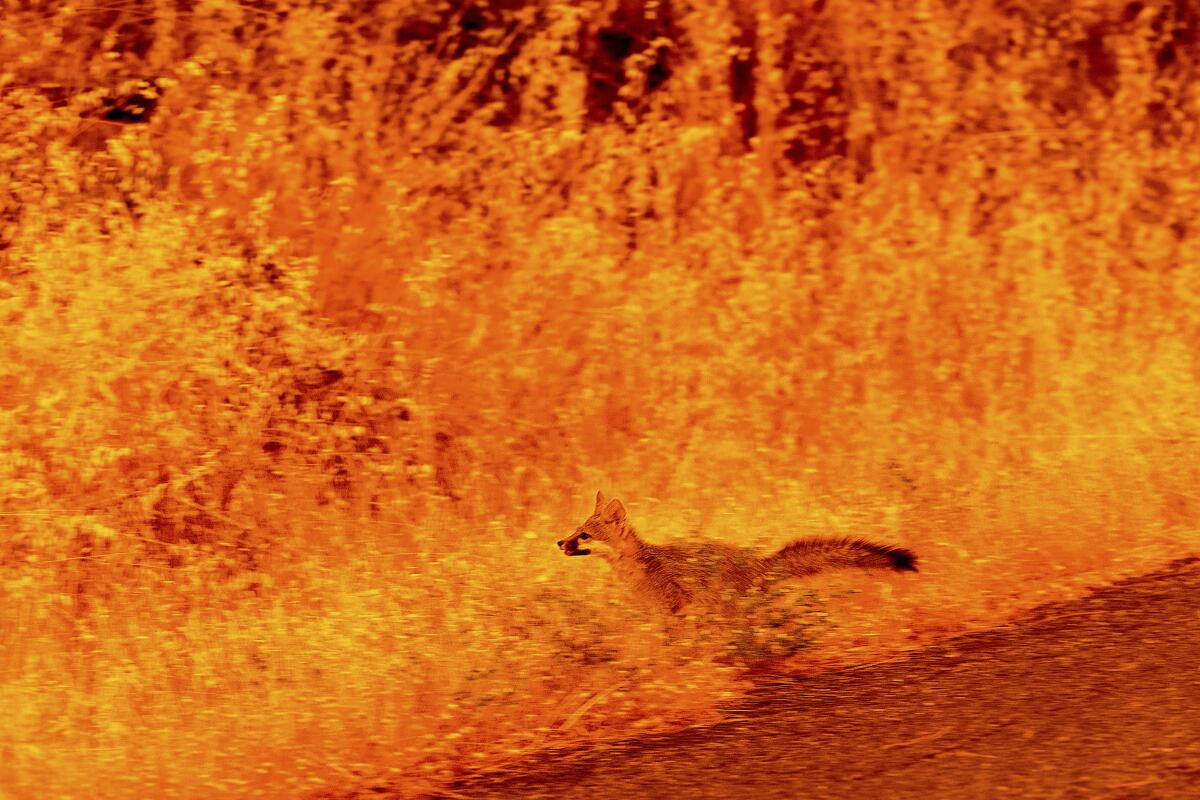
Tracy, the Park fire incident spokesperson, said some of the extreme behavior displayed in that fire’s early hours appears to have slowed, such as tornadolike “fire whirls” sometimes referred to as “firenados.”
But is is continuing to spew considerable smoke, with federal smoke maps showing plumes from the fire reaching as far as Oregon and Nevada.
The Park fire has prompted several road closures and the closure of Lassen Volcanic National Park. Evacuation shelters are available at Neighborhood Church in Chico and Los Molinos Vet’s Hall in Los Molinos. Large and small animal shelters are also available in Oroville, Red Bluff and Corning.
The race between the weather and the firefight will continue in the days ahead, Tracy said.
“If the weather continues to cooperate, then we’ll be able to continue this direct attack and start to button up more containment,” he said.
More to Read
Sign up for Essential California
The most important California stories and recommendations in your inbox every morning.
You may occasionally receive promotional content from the Los Angeles Times.
